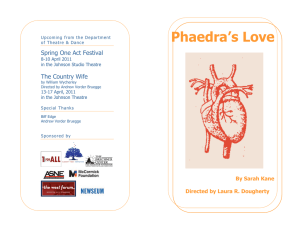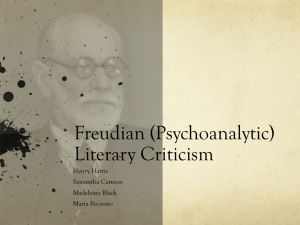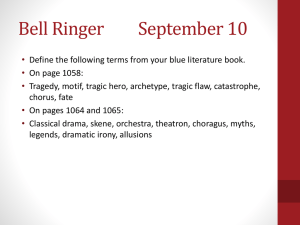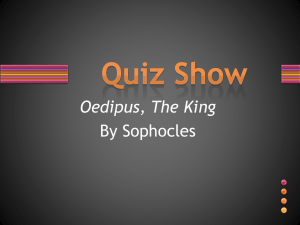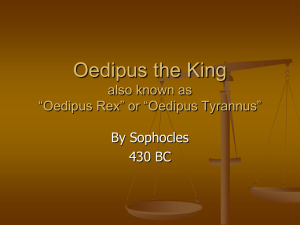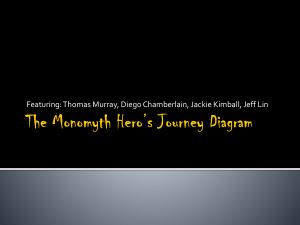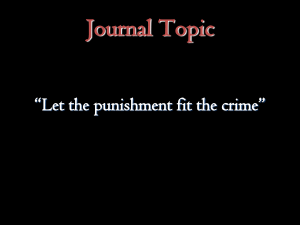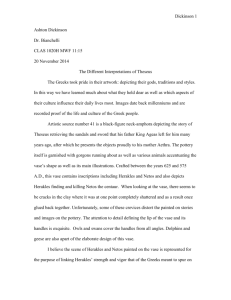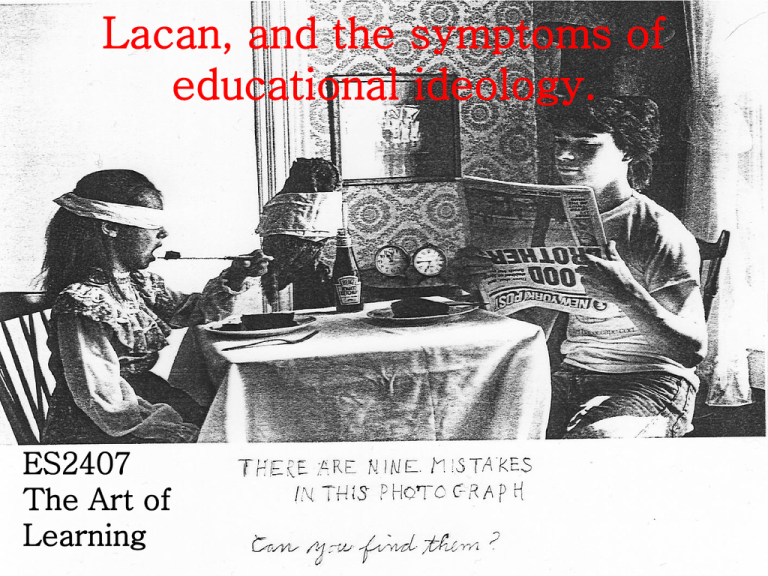
Lacan, and the symptoms of
educational ideology.
ES2407
The Art of
Learning
The introductory text to the illustrations
of lacanian fantasy discussed the idea of
thinking about society as though it were a
person, generating images and figures as
social fantasies - symptoms of ‘its’ mass
ideological formations. The task now is to
search for symptoms that might
reasonably be associated with education.
We will do this by thinking about ideology
in general, and then employ a number of
classical myths to tease out those
ideologies that seem central to education.
The last chapter in Zizek’s The Plague of
Fantasies is entitled, ‘Cyberspace, or, the
unbearable closure of being’. In the first section
he discusses the notion of symptom in relation to
social ideologies.
His starting point is the absolute nature of
ideology itself. Once it is implemented, its
particular principle of formation runs through
every instance of content – think of ideology as
being like a frame. So, within it, the issue of
whether or not a particular content is present or
not is contingent – and of no significance to the
maintenance of the ideological domain itself, or a
threat to its universal truth.
But to quote Zizek,
‘A symptom, however, is an element which
– although the non-realisation of the
universal principle in it appears to hinge
on contingent circumstances – has to
remain an exception, that is, the point of
suspension of the universal principle: if
the universal principle were to apply to
this point, the universal system itself
would disintegrate.’
Think of feminism’s advance. In every instance the
assumptions of an exclusive masculinity – in respect of
deity, kingship, wisdom, intellectual prowess, and even
the warrior virtues – have had to eventually
accommodate the presence of women as symptom.
Such symptoms appear as either ‘tokens’ satisfying
some higher, extra-ideological principle, or else appear
in disguise – as compromised forms of femininity which
avoid overt conflict with the universal principle. As
Zizek indicates, the alternative – full acceptance of their
status as women – leads to the collapse of the prior
ideological system, i.e., the combination of universal
principle and contingent content – now seen to be not so
contingent as all that. In effect, then, the symptom is a
necessity generated by the ideological structure itself.
To further illustrate this example we
need some sexualised ‘symptoms’ to
think with, and since this is such a central
aspect of contemporary society, it’s
reasonable to ask if our education system
responds in a particular way. In fact does
it even recognise the difficulties faced by
those who are expected to act as
‘tokens’, or those who are condemned to
fulfil patriarchal assumptions of
femininity? And if it doesn’t, what does
this tell you about its ideology?
I. Athena - goddess of wisdom,
justice, civilisation, strategic
warfare, the female arts, and the
virgin patron of Athens. She is
the daughter of Metis, a Titan,
whom Zeus swallowed after
coupling with her so as to avoid
a prophesy that their progeny
would be greater than himself.
But Metis was already pregnant
and gave birth to Athena inside
Zeus. Later, suffering from a
terrible headache, Zeus asked
Hephaestus to split open his
forehead, from which Athena
burst forth fully armed with
weapons given to her by her
mother.
II. Pandora - first woman and
the origin of evil. Her name
means ‘all-gifted’, since each
god gave her a unique gift to
add to her seductive charms.
Zeus had ordered Hephaestus
to mould her out of earth as a
‘beautiful evil’ – to balance the
benefits of fire given to men by
Prometheus. Epimetheus, his
brother, accepted her as a wife
– despite Prometheus’ warning.
For her dowry she brought a
jar holding all the evils of the
world, and once on Earth she
opened it, releasing them, until
only hope remained inside.
Clearly, Athena is no token! But, nevertheless, her
femininity is disguised so as to match a still dominant
patriarchy. She has an almost masculine face, and any
obviously feminine or maternal physical qualities are
hidden by her clothing and military equipment. Not only
does she carry a spear and shield, she also wears a
helmet and chest armour that presents the head of a
gorgon. She has no lovers, is a virgin, and even as an
adoptive mother her ‘son’ is always represented as a
serpent. Finally, and perhaps of most significance, her
birth ‘mother’ is Zeus, the father of the gods. The
principal fantasy at play here seems to be what Zizek calls
the ‘impossible gaze’ – the narrative creation of a selfwitnessed moment of ‘birth’ to account for the
reconfiguration of the symbolic order that she herself
bring about – to some degree. She is emblematic of a
state of transition.
Given the history of the Twentieth Century, it is
remarkable that even towards the end of that
century our education system offered no
information about an experience that half the
school population were likely to face at some time
during their working lives. Today, the problem
has not gone away; and arguably, it is even more
of a requirement than before. The remaining
‘bastions’ of masculine exclusiveness are deeply
entrenched, while many areas of apparent sexual
equality still resist the breaking of their own
‘glass ceilings’. Men also are beginning to
experience equivalent transitions as they enter
work places previously assumed to be exclusively
‘feminine’, such as nursing and infant education.
If education’s silence about transitional experience is
surprising, its silence with respect to the implications of
the Pandora figure is deafening: she figures in the
education of every pupil, be they male or female, beautiful
or plain, accepting or rejecting their implied social role.
As the seductive bringer of evil she is neither token nor
transitional form. Her first ‘veil’ of fantasy is the
transcendental schematism of desire – teaching men how
to desire and women how to be desirous. Her second veil
is the inter-subjective. Here, she introduces the
mysteries, risks, and specific co-ordinations within the
symbolic order intrinsic to gendered inter-subjectivity.
Her own entry into this order is as the carrier of the Real
– the troubles and confusions which irrupt through the
ordered surfaces of the world. And, finally, hope itself is
her agalma, that within her which is greater than herself.
Athena and Pandora offer simplified
ideological figures/models which can be
used to tease out the ideologies and
symptoms associated with education
under patriarchy. As we have just seen,
we drew two blanks which were highly
significant because of their relevance to
society and experience in general, and
yet the official education system ignores
them – what is this telling us about the
nature of this education?
The next set of figures provides us
with insight into the ideologies of
teaching itself. Note that here we
recapitulate many of the risks
associated with the psychoanalytic
‘transference’.
The most obvious aspect of this is the
assumption that the ‘good’ teacher
will make enlightened interventions –
and so, to the Master’s workshop!
III. Pygmalion was a
sculptor who lived on an
island where the women
had rejected the deity of
Aphrodite. In response,
she made all the women
permanently promiscuous –
and Pygmalion began to
live alone. He dreamt of a
perfect woman, and to
relieve his loneliness he
made a statue of his
fantasy. He loved it - and
dressed it in precious
clothes and jewels. Taking
pity on him, Aphrodite gave
life to his statue.
The ideology for which Pygmalion may figure as
model is not simply one keen to police any
impropriety between teacher and pupil – refer to
Socrates in his Symposium. It features instead
the risk of any pupil-teacher relationship - one in
which the teacher is given licence to transgress
the respect for separate identities normally
accorded to private individuals. (The phrase, ‘in
loco parentis’, is often used as an epithet for
much that is unusual about public schooling.)
Pygmalion’s ideal statue implies that although this
process will result in a new ‘life’ for the pupil, it
will be one determined by the teacher according
to his/her desire. Cf. Michaelangelo: I find and
release forms hidden in the stone.
In lacanian terms, rather than the teacher acting as a
specialised token for symbolic authority, s/he has allowed
herself to regress to the realm of the Imaginary subverting her pupil’s entry into the symbolic – offering
herself as the authority – the Other – one ruthlessly
searching for its own image reflected in the responses of
its ideal students. This is in opposition to working
‘through’ the pupil’s transference so as to eventually
release their individuality. (See, for example, The Prime
of Miss Jean Brody, but also The Dead Poets Society.)
Recall also that narratives impose temporal distance
between contradictions existing within the same context,
imposing a before and after, allocating victory to one side
and defeat to the other. The myth of Pygmalion tells of
how godliness might be rewarded, but Mary Shelley’s
Frankenstein offers an ironic riposte.
IV. Ariadne, daughter of King Minos
of Crete, has a half-brother – the
Minotaur: half man, half beast –
trapped in Daedalus’ labyrinth. Her
other brother is killed in Athens Minos attacks, defeats the city, and
demands that it sends seven youths
and seven maidens every nine years
to Crete as sacrifice to his other son.
Theseus, future ‘father’ of the new
Athens, joins the victims. Ariadne
falls in love on first sight and plots
his escape. Before the sacrifice, she
leads him to the labyrinth, giving him
a sword and spindle of thread. Using
these, Theseus kills the monster and
escapes from Crete with Ariadne, but
later abandons her on Naxos.
Clearly, we witness another moment of birth – and a
different model of the ‘good’ teacher. In this,
Ariadne appears at first sight to act as both selfsacrificing guardian and guide to her pupil-hero,
Theseus, who will follow her lead through love, but
then discard her.
But we know that narratives typically transcribe
co-present contraries into a before-and-after
structure, so the direct reading of this myth is that
the triumph of Theseus over the Minotaur conceals
two opposing ideas. Both the monster (Ariadne’s
half-brother) and the future-hero are products of
the co-mingling of gods and mortals - even sharing
the same godly ‘father’: Poseidon.
So it is more accurate to think of the Minotaur
as a shadow image or negation of Theseus – its
singular bestiality matching his heroism.
Consider, then, Ariadne’s spindle of red thread;
the gender associations are clear (and didn’t
Socrates describe himself as a ‘midwife’?),
Equally, knots and thread have always been
associated with problems and their solution.
The labyrinth is both complex knot and problem:
Theseus must solve them both; but this will
involve self-mutilation – his ‘shadow’ must die
so that a new self-image can shine more
brightly. On this reading, progress will involve
no more than the denial of ‘base’ impulses, etc.
The lacanian conclusion is more daunting
than this suggests. The price of progress is
not simply the denial of some part of the
self. With each step upward and forward,
the pupil-hero’s shadow shifts – and as it
does so both the labyrinth and the Minotaur
also change their nature. Ariadne (the
teacher) is less a guide than a guardian, and
less a guardian than a messenger of
constant difference: ‘Here heroism will find
no final resting place – other than your final
fall.’
The next two models help to make explicit
further complexities in the pupil-teacher
relationship. Both Phaedra and Medea have
served as the central protagonists in many
plays, novels, musical works, and in the
case of Phaedra, a film. There are,
therefore, for the first time, versions that
can be chosen to match one’s analytic focus.
Each figure presents a married woman with
children who is provoked to question the
stability of her marriage. In each case, the
response is extreme.
V. Phaedra is another daughter of Minos and Pasiphae. She
marries Theseus and has two sons by him, and also
becomes mother to Hippolytus, Theseus’ son by a previous
marriage.
The simplest version of
the myth has Phaedra
falling in love with her
step-son, who spurns her.
In revenge, she tells
Theseus that Hippolytus
raped her. Theseus
responds by calling on his
father, Poseidon, to kill the
youth.
The god sends a huge bull from out of the sea which
stampedes Hippolytus’ horses as he passes in his chariot.
He is pulled into the reins and dragged to his death. On
hearing of this, Phaedra kills herself in guilt and remorse.
VI. Medea uses magic to
help Jason win the Golden
Fleece, and helps him to
escape with her by killing
one of her own brothers.
She becomes Jason’s wife,
and bears him two sons.
Later, he discards her so he
can marry a younger and
more respected princess.
Medea responds by killing
the princess, the girl’s
father, and then her two
sons before fleeing to
Athens.
As with Pygmalion, there are explicit sexual relationships in
both myths that can limit the scope of application, but if these
are put to one side, one has a powerful analytic model to
think with. In the case of Phaedra, the obvious response is to
take the educational interpretation as a warning against
excessive emotional attachment on the part of a teacher for
any of the children in their charge. More developed versions
of the myth move matters further on. Hippolytus is said to
spurn Aphrodite, goddess of erotic love and sexual beauty,
preferring to remain a virgin devoted to Apollo’s twin sister,
Artemis, goddess of the hunt and of nature, a virgin herself
but also goddess of birth and nurture. It is therefore
Aphrodite who fills Phaedra with lust for Hippolytus, in
revenge for her rejection; and Phaedra spends the rest of
what remains of her life trying to fight against this enforced
desire. What is striking in this revised figuration is that both
the ‘teacher’ and the ‘pupil’ suffer because they reject the
entry of love – however understood - into their relationship.
Our interest in a wider sense of education may therefor
suggest an analysis in which both ‘teacher’ and ‘pupil’ are
seen to be at fault in refusing the changes to themselves
that will be brought about through mutual affection. The
idea of a more experienced woman entering into a positive
sexual relationship with a less experienced younger man is
still in the process of becoming acceptable in literature and
film, e.g. The Graduate . But there are many examples
where relative equality, often despite the patriarchal norm
of rejection, becomes the eventual basis for mutual growth,
e.g. Pride and Prejudice, North and South, and even Women
in Love. But the myth of Phaedra is, in fact, set in motion
by the pupil’s initial offence: Hippolytus rejects the power
of love, and the myth continues to circle around this fact.
Transcribing this, the pupil rejects desire – his/her lack –
as a source of radical change to self. Both Freud and
Lacan think all desire is, ultimately, a desire to be loved, so
analysis starts here – leading, perhaps, to Narcissus.
There are a number of variations to the myth of Medea.
The story of filicide seems to have been Euripedes’ own
invention, but it has become a constant feature since
then. The general assessment of the relationship
between Jason and Medea is as follows: this is a story
that starts with treachery and murder, and ends with
suspicion, jealousy, and merciless revenge. You should
know by now, however, to start your own analysis by
placing the more striking aspects of a myth in brackets –
releasing them selectively as your transcription proceeds.
N.B. some versions have focussed on how Medea has
little choice but to kill her sons since their fate – if Jason
denies their inheritance – will be exile, death, or slavery.
Various transcriptions suggest themselves based on this,
but start by making Jason the teacher, Medea the pupil,
and her children Jason’s ‘teachings’. Now reverse this to
get the feminist reading, and try ‘teachings’ = poison!
The last illustrative models feature the idea
of educational trajectories. Plato’s The
Death of Socrates illustrates the rise and
apparent ending of a quest for wisdom,
while Oedipus is used by both Freud and
Lacan to model the transition of the child
from family to society. We consider here a
question raised in the notes on Freud for
Education, Social, and Political Thought:
does the myth of Oedipus adequately
express feminine experience of this
transition?
VII. Oedipus. King Laius and
Queen Jocasta of Thebes are
warned that if their child is
allowed to become an adult it will
murder his father and marry his
mother. The king orders the
child’s feet to be pinned together
and the infant abandoned. It is
rescued by a shepherd, and later
adopted as the son of another King
and Queen. As a youth, Oedipus is
warned he will kill his father and
marry his mother, so he flees his
home. On his travels he meets an
elderly stranger, they quarrel, and
Oedipus kills him. Oedipus reaches
Thebes – besieged by a monster,
the Sphinx.
The monster eats anyone who cannot answer its riddle:
which animal has 4 feet in the morning, 2 at midday, and 3
in the evening? Oedipus replies that it is Man, the Sphinx
screams in fury, and vanishes back into an abyss.
Oedipus becomes the hero of
Thebes, and he marries the
recently widowed Queen, (his
own mother) Jocasta. They
reign in peace for some ten
years and have a number of
children together – then
plagues break out in the city.
The famous prophet, Tiresius, is called. He declares that
the plague will only end when the murderer of King Laius,
Jocasta’s previous husband and Oedipus’ father is
found. Oedipus turns ruthless detective and soon the old
shepherd who had originally rescued him is discovered.
The shepherd’s testimony,
and other evidence, point
conclusively towards Oedipus
himself as the
murderer. Jocasta, both his
queen and mother, runs into
the palace and hangs herself
in their bedroom. Oedipus
blinds himself with her clasp
as he accepts his own guilt.
He begs that he be banished
from Thebes, but one
daughter from his incestuous
marriage volunteers to
accompany him as a guide;
she is called Antigone.
Analysis of the Oedipus myth as a model of an
educational trajectory will take place in the lecture. As
you now know, as far as feminine experience of individual
agency is concerned, the shift from family to society is
theorised as being dominated by the recognition of lack.
For Freud it is the literal lack of a penis that drive’s the
young girl to eventually become reconciled to her
physical castrated state: for Lacan, castration is shifted
to the Symbolic Register, but he also thinks that a
woman’s ability to exercise agency within this realm is
always dependent on being able to co-opt forms of
masculine agency.
One of Freud’s followers, C. G. Jung, suggested that the
myth of Electra could provide a more suitable model for
feminine experience. We therefore end this PowerPoint
with a summary of the Electra myth that will be used in
discussion.
VIII. Electra plots with Orestes, her brother, to kill her
mother, Clytemnestra and Aegithus, her step-father, for
murdering her actual father, Agamemnon.
This murder is itself
prompted by the fact that
Agamemnon sacrificed
his oldest daughter,
Iphigenia, in order to get
Artemis to allow him and
his fleet to leave Athens
and sail to Troy, thus
beginning the Trojan
war.
Electra and Orestes succeed in their plan, but then have
to atone for their shameful act by purifying their souls.
(By far the strongest version is developed by Sophocles.)
A Reminder
The following sequence of developmental experiences seems to be well
established: primary bonding with the mother or principal care-giver,
corresponding to sensation being organised around the mouth. Subsequently this
moves to control of the faeces and the anus, and at about the age of 4 – 5
attention shifts to exploring the genitals and the pre-sexual pleasure they can
generate; the child also becomes intensely curious about any observed differences
in genital anatomy between individuals during this ‘phallic’ stage. Rather than at
adolescence, then, psychoanalysts locate the Oedipus Complex at this early time
within the individual’s life. Essentially, the ‘complex’ amounts to that experiential
process by which the individual comes to associate themselves with the same-sex
individual within the family setting, and at the same time relinquishing any
thoughts of competing against this same half of the partnership for the love of the
opposite partner, accepting, therefore ex-familial heterosexual social
relationships, and initiating the formation of a super-ego modelled on the ‘lawgiving’ capacity of the same-sex partner.
Both sexes start by loving the mother. In the case of boys, what then drives this
process is the fear of castration by the father. Girls come to recognise they lack a
penis (‘penis envy’) and therefore cannot compete against the father for their
mother’s attention. Initially, they blame their mothers for this assumed
imperfection, but later become reconciled with their mothers through the
formation of a superego, i.e., they come to accept their ‘castrated’ state and redirect their affection towards the father or father-substitute.
D.M.B. 2011.

